

19 Short Stories and Questions For Critical Thinking
Apr 2, 2024
There have been rumblings in different online teacher groups recently about replacing novels with short stories and informational articles in middle and high school English classrooms. I have to admit I was shocked when I first read the comments because I am a book lover at heart, but since then, I’ve considered that there are several pros and cons to this approach.
Short stories and other smaller texts can provide a briefer timeline to complete tasks, and this process is helpful when there is already SO MUCH curriculum to cover. Short stories and related activities can also be more engaging for our students because of the exposure to diverse voices and themes! Using short stories and lessons provides students with amazing choices to meet their needs and preferences!
On the other hand, incorporating mainly short stories and other shorter passages means students’ already-pressed attention spans (as a result of social media influences and pervasive sources of technology) are reinforced. Plus, students miss out on the more complex stories within longer pieces of fiction that are, dare I say, life-altering! A novel can provide opportunities for sustained reading and layers for analysis that shorter pieces of literature like short stories and related texts cannot offer.
Ultimately, no matter where you find yourself on the issue, I think we can all agree that short stories and their counterparts can be vital, effective, and helpful in the modern classroom!
Continue reading for 19 Short Stories and Questions For Critical Thinking!!
Need help with Test Prep ? Check out this FREE Pack of 3 Test Prep Activities to help students achieve success on standardized tests!

Table of Contents
19 Short Stories and Questions – Suggestions for Teaching Them
You don’t need to remove all novels to be able to include short stories and smaller passages like vignettes, articles, and narratives; there’s a time and place for all genres! But if you’re thinking about ways to include more short stories and fun activities, check out this list of 19 varied short stories and critical thinking questions as well as suggestions for teaching them in middle school and high school.
1. “The Most Dangerous Game”
“The Most Dangerous Game” is one of my absolute favorite short stories and overall plots to teach! This suspenseful short story by Richard Connell follows the harrowing ordeal of Sanger Rainsford, a skilled hunter who becomes the prey of a deranged aristocrat named General Zaroff. Stranded on Zaroff’s secluded island, Rainsford must outwit the cunning general in a deadly game of survival, where the stakes are life and death.
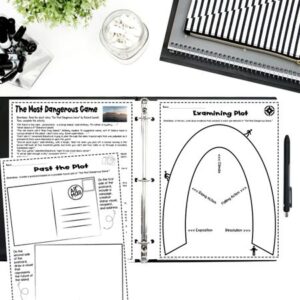
SUGGESTIONS FOR TEACHING:
- You could focus on the setting (description of time and place) and examine how the setting changes throughout the story.
- Students could learn about the plot (major events in the story) and list the major events and evidence as they read.
- Define foreshadowing (hints for what will happen by the end of the story) and encourage students to hypothesize about what will happen after every page.
- Analyze the character development (how a character changes over time) of Rainsford and highlight his traits/actions as you read along.
CRITICAL THINKING QUESTIONS:
- How does the setting contribute to the tension and suspense in the story?
- How does the author use foreshadowing? How does the author hint at the danger Rainford is facing?
- What inferences can you make about the main character and the changes he undergoes from the beginning to the end of the story?
If you want to teach plot elements and plot analysis , check out this lesson bundle for the story , which includes comprehension quizzes and a variety of activities!
2. “An Occurrence at Owl Creek Bridge”
Ambrose Bierce’s story is a gripping tale set during the American Civil War, where a Southern civilian named Peyton Farquhar faces execution by hanging after attempting to sabotage a Union railroad bridge. As Farquhar falls through the trapdoor, time seems to stretch, and he experiences a surreal moment, only to realize his grim reality.
Integrating historical texts with other short stories and passages like “An Occurrence at Owl Creek Bridge” will make history come more alive and relevant for our students!
- Teach about irony (when the opposite occurs from what is expected) and how it plays a role throughout the story.
- Explain the term characterization (how a character is depicted) by looking at direct and indirect references while reading with your students.
- Discuss the major themes (messages) of the story and how they connect to our modern era within a Socratic Seminar.
- How does the author use characterization to convey Peyton Farquhar’s thoughts, emotions, and motivations?
- What is the purpose of irony in this story? How does its use affect the reader’s interpretation and understanding of events?
- What is the significance in our contemporary/real world of the themes of the story, including reality and fantasy, the passage of time, and the consequences of actions?
Ensure students’ understanding of the story with this set of reading questions that are perfect for state test prep, too !
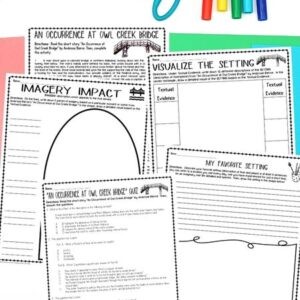
3. “The Masque of the Red Death”
This chilling tale from Edgar Allan Poe is set in a secluded abbey where Prince Prospero and his wealthy guests attempt to escape a deadly plague known as the Red Death. Despite their isolation efforts, the guests are confronted with their own mortality as a mysterious figure in a blood-red mask appears.
If you have not read any short stories and poems from Poe, this story is a perfect journey into the horror genre!
- The setting (description of time and place) plays a MAJOR role in the story, so following the Prince from room to room and highlighting the imagery (description that connects to the five senses) is very important when reading.
- If you have not introduced mood (emotion intended for the reader to experience), this story is PERFECT for delineating its progression from start to finish.
- As students read, you might guide them through identifying various examples of symbolism (object, person, or place that represents something else); each room, objects within, and the “antagonist” is symbolic in some way!
- How does the author convey the tone of the story? How would you, as the reader, describe the story’s mood?
- What role does the plot structure (focus on the different rooms) play in shaping the reader’s understanding of the story?
- What is the purpose of the symbolism in the story such as the clock and the masked figure?
Check out this EASY-TO-TEACH bundle , you can practice with your students, so they will feel more confident analyzing higher-level language in “The Masque of the Red Death!”
4. “The Cask of Amontillado”
Another chilling tale from Poe is the classic story “The Cask of Amontillado.” This one is set during Carnival in an unnamed Italian city. The plot centers on a man seeking revenge on a ‘friend’ he believes has insulted him. If your students are anything like mine, they will relish the ending particularly!
This is just one more of Poe’s short stories and tales that will capture the mind of every reader!
- As you plan for this short story, be sure to encourage your students to analyze the changing setting (description of time and place); following Fortunato from scene to scene will help your students track what is really going on.
- This story is the perfect moment to teach about dialogue (conversation within someone=internal and/or between someone and someone/thing else=external); Montresor certainly means more than what he SEEMS to say!
- You might also offer a mini-lesson on the 3 types of irony and how each plays a role in the story: verbal (when a person says the opposite of what is really intended), situational (an action occurs that is the opposite from what the reader expects), and dramatic (a character expects a result, but the opposite occurs and the audience can tell what will happen)!
- Describe Montresor. What are his motives and personality?
- What inferences can you make about Montresor’s mindset based on his dialogue?
- What is the purpose of the family’s motto and the carnival atmosphere?
Check out this Short Story Activity & Quiz Bundle for Edgar Allan Poe’s “The Cask of Amontillado,” which contains questions and answers modeled after various reading standardized tests as well as pre-quiz reading comprehension questions, graphic organizers, and a writing activity to get students thinking critically about this classic short story involving REVENGE!
Want 7 more teaching ideas for one of Poe’s epic short stories and questions to go with it? Click below!
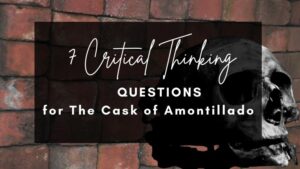
5. “To Build a Fire”
This story by Jack London describes the treacherous journey of a man through the harsh Yukon wilderness during extreme cold. Despite warnings and the company of a loyal dog, the man’s arrogance and underestimation of nature’s power lead to a tragic end.
Short stories and ideas related to survival in nature are still relevant today! Who knows when you might get lost on a hike or crashland in no man’s land?
- This story is PERFECT for a bit of literary analysis (examining the impact of various ideas, elements, or themes within a piece of literature); you could hone in on literary devices, characterization, theme, etc.!
- Integrating clips from survival shows will help students see connections to the world and extend their thinking by comparing (recognizing similarities) and contrasting (recognizing differences) varied experiences!
- Write a short narrative about surviving 24 hours in a different setting (description of time and place).
- How does the author use irony? Provide an example and explain.
- What real-world connections can be made between this story and our contemporary life?
- What is the story’s message about preparedness and respecting nature?
Grab these engaging short stories and activities to make teaching this Jack London story stress-free!
6. “The Cactus”
Told from the point of view of a young man at his former lover’s wedding, the narrator retells their story. Like most of O. Henry’s short stories and texts, this one has a twist that involves the titular cactus plant.
The ending will end in a bit of fun for your students!
- Introduce diction (word choice) and its impact within the story by hyperfocusing on specific words within the story . Students can look up definitions, locate synonyms, create their own sentences, replace the words, etc.
- Investigate twist endings (unexpected finish to a story); before reading the end of the story, ask students to guess why the girl “rejected” him. Some students may know the answer before reading it!
- Describe the main characters. What similarities and differences are evident? How does this affect the story’s action?
- What inferences can you make about Trysdale and his feelings about love and marriage?
- What are the real and symbolic meanings of the cactus?
This resource packed with questions and answers, graphic organizers, and writing activities is sure to get your students thinking about this love story driven by misconceptions.

7. “After Twenty Years”
This tale of friendship and betrayal focuses on the reunion of two old friends after twenty years apart on a New York City street corner. As they reminisce, something is revealed that demonstrates the reality of their bond as well as the choices they’ve made in life.
If you have not read O. Henry’s short stories and incorporated character analysis yet, this is your chance! The story is not long and can be completed in one to two class periods!
- Sometimes, we ask students to visualize (create a picture) in their minds, but why not give them the opportunity to use their artistic skills to draw the two characters?
- As students read, annotate for a description of each character; then, students can do a character analysis (investigation of the characters’ similarities and differences).
- What type of irony is used in the story? How does its use affect your interpretation and understanding of the story?
- How does the urban setting contribute to the mood of the story?
- What is the story’s message about friendship and loyalty?
Examine the links between loyalty and duty with this set of resources designed specifically for this O. Henry story.
8. “The Lottery”
“The Lottery” is the quintessential short story for middle school or high school English! Shirley Jackson’s “The Lottery” tells the story of an annual ritual that takes place in a seemingly idyllic town. When the townsfolk gather for the lottery drawing, a shocking turn of events demonstrates the dark side of human nature and their ties to (outdated) traditions.
- Introduce the terms suspense (uncertainty and/or excitement leading up to a major event) and tension (anxiety or uneasy feelings experienced by characters). While reading, identify evidence that relates to each of these concepts and chat/write about their impact on meaning and plot.
- Teach title (the name of the text) analysis. The title of “The Lottery” is perfect for teaching the impact of the title and audience expectations. Before reading, students may write what they believe the story will be about based on the title. After reading, students can complete a quick write responding to their previous expectations! You can do a text analysis for all short stories and poems!
- What role does the plot structure play in building suspense and tension? (Consider the revelation of the lottery’s ‘prize’ in particular.)
- What social commentary is being made through the story and its characters?
- Describe Mr. Summers, Tessie, and Old Man Warner. What does the story reveal about their role in the community and their feelings about the lottery?
Give yours elf a breath of fresh air with this NO PREP curriculum that integrates test prep within the teaching of literature by using Shirley Jackson’s quintessential story!
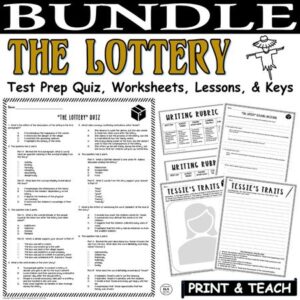
9. “The Pedestrian”
This Ray Bradbury story follows a lone walker in a futuristic society in which everyone else is consumed by technology, particularly the television. One evening, the walker encounters a police car that questions his unusual behavior and the end is quite unexpected! (Most of Bradbury’s short stories and texts connect to the future and technology in some way!)
- This story exemplifies Dystopian Literature (texts that include a supposedly perfect future society marred in some way by governmental or societal oppression). Using this story to introduce this type of literature is always fun for students because they will easily make connections to other dystopic short stories and poems!
- Teach about mood (the emotional impact of a story’s description/action). The goal is to get students to deepen their critical thinking skills by recognizing how the mood changes and the purpose for that change!
- How does the author use foreshadowing and suspense to build the mood of the story?
- What is the central theme of the story? How might it connect with our current world?
- What similes and metaphors does Bradbury use to describe the community and its members? What is notable about these comparisons?
With this resource about Bradbury’s “The Pedestrian,” you can just print and teach the lesson and activities with EASE!
10. “The Gift of the Magi”
This 1905 story by O. Henry relays a tale about a couple struggling to make ends meet. Throughout the story, they both figure out gifts to buy one another for Christmas and realize what love truly means!
- Review character traits (how a character is depicted internally and externally). Log the traits of each character within the story and how they are important to the meaning of the story.
- Extend (move beyond the text) critical thinking skills by encouraging students to think and write about other people. If they had $1,000 to spend on someone else, how would they spend the money and why?
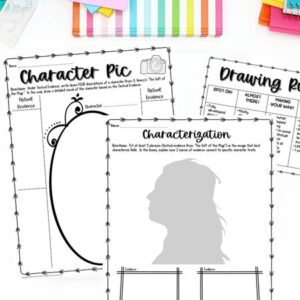
- How would you describe Della and Jim, and their relationship?
- What values do the characters have, when you consider their actions and decisions?
- Explain how dramatic irony is used in the story. Is it necessary? Is it effective? Why or why not?
This tale is a great addition to your short stories and questions unit around the winter holidays! Save yourself time at that time of the year with this lesson bundle .
11. “The Monkey’s Paw”
“The Monkey’s Paw” is a classic horror story about the White family who come into possession of a mystical monkey’s paw that grants three wishes. Despite warnings, they use it and then face devastating consequences as a result.
- Teach about the elements of the horror/suspense genre (Ex. Scary movies are typically dark, stormy, surprising, morbid, etc.).
- Create a thematic statement (message relayed by the text in a complete sentence). There is no perfectly created theme (message) unless it is directly stated by the author; however, students can create a theme by supporting their ideas with evidence from the story!
- What is the main theme of the story? Or how does the author communicate the themes of greed or fate? Is one stronger than the other?
- Are Mr. and Mrs. White more alike or different from one another? How do you know?
- Should we be afraid of the unknown? What message does the story share? Do you agree or disagree?
Examine W.W. Jacobs’ classic story with this set of questions and answers along with rigorous reading and writing activities . While it is ideal for a spooky season, the story is valuable for its ability to hook readers any time of year!
12. “Lamb to the Slaughter”
This classic story with a killer plot twist is about a woman who kills her husband and gets away with murder thanks to cooking a leg of lamb!
- You could introduce the plot elements (exposition, rising action, climax, falling action, resolution), encourage students to identify major events to fit each element and write down textual evidence to support their ideas.
- Complete a film analysis (examination of film techniques and their effects) to compare/contrast the short story with the classic Alfred Hitchcock television episode.
- What is Mary Maloney’s state of mind? Does it remain the same or does it change throughout the story? Explain.
- Is the resolution of the story satisfying? Why or why not? Why do you think the author ended it as he did?
- How does irony contribute to the theme of deception in the story? Explain.
Spice up your middle school English or high school English class with this short stories and activities bundle for Dahl’s famous story!
13. “The Tell-Tale Heart”
Poe’s classic psychological thriller is narrated by an unnamed protagonist who insists on their sanity while recounting how they murdered an old man. The narrator is haunted by the sound of the victim’s beating heart, which ultimately drives him to confess to the crime despite not originally being a suspect.
- Teach symbolism (object, person, or place that represents something else) by focusing on the heart and eye . The author used these symbols in various ways!
- Investigate psychology (the study of the human mind) as a part of the story. Determine what is fact and what is fiction within the narrator’s mind.
- What does the story reveal about the human psyche?
- What is the deeper meaning of the two key symbols in the story – the beating heart and the eye of the old man?
- What role do the narrator’s inner thoughts play in the development of the plot?
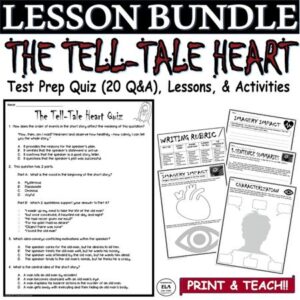
This Short Story Comprehension Bundle offers quick (and effective!) ways to assess students’ learning and understanding of the story. It’s easy to use and will no doubt save you time too!
14. “The Scarlet Ibis”
Emotional short stories and their counterparts have a place as well in English classrooms! This short story by James Hurst about two brothers is a heartbreaking must-read. Through flashbacks, the unnamed narrator tells the life story of his younger sickly brother William Armstrong, who is nicknamed Doodle. And the end…well, you’ll see.
- Define and explain the purpose of a flashback (referring back to the past within a story). Think about the implications of never thinking back on the past or always thinking about the past.
- Complete a comparison chart between Doodle and the Ibis as you read along. Then, students can create a visual of each after they have ready by using their own evidence!
- What is the meaning of the story’s title and the presence of a scarlet ibis in the story?
- What is the central theme of the story? How do the events of the story support this chosen theme?
- How does the author use personification for the storm? What effect does this have on the story?
This flexible resource features critical thinking questions and answers as well as writing and reading activities for students to explore Hurst’s heartbreaking story.
15. “The Veldt”
This science fiction story by Ray Bradbury was first published as “The World the Children Made” and it is quite fitting as a title! The story focuses on a futuristic world in which a video screen can be controlled and it turns out to be more than simple virtual reality! By the story’s conclusion, the world the children made is the downfall of their parents.
- Compare and contrast “The Veldt” with “The Pedestrian,” two short stories and dystopic texts by Ray Bradbury. Analyze the similarities and differences of both short stories and create a thematic statement that connects to both texts!
- Make connections to our current reality in the 21st century. Locate research about the implications of technology on young people and integrate this information as you discuss this short story.
- How does the author address the theme of technology versus humanity in the story? Do you agree with this commentary? Why or why not?
- How does the nursery reflect the personalities of Wendy and Peter in this story?
- Do you know the story of Peter Pan and his friend Wendy? What connections can you make between it and this story by Ray Bradbury?
Ray Bradbury’s classic short stories and similar passages are the BEST to teach in middle and high school English! With so much to dive into, they are sure to be a hit with your students. Grab this set of activities to extend your students’ engagement with rigorous reading and writing activities about “The Veldt.”
16. “The Necklace”
A woman who longs for a life of luxury and elegance beyond her means faces consequences when she loses a borrowed necklace. Guy de Maupassant’s story ends with a twist that has the reader question the value of material possessions.
- I love comparing this short story with O. Henry’s “The Gift of the Magi.” You might choose to focus on the theme, characterization, setting, etc.
- Summarize (writing about the main idea with details) each chunk of the story as you read with your students. Instead of asking students to write a paragraph, you could ask students to create each summary in only one sentence.
- The story explores vanity, deception, and the consequences of striving for social status. Which theme do you think is the most important? Explain with support from the story.
- Is Mathilde Loisel a likable character? Does this change during the story? Does it matter if the reader likes her? Why or why not?
- What clues does the author provide throughout the story that foreshadow the twist at the story’s end?
Focus on the standards with this Short Story Lesson Bundle for “The Necklace” by Guy de Maupassant!
Need help with implementing activities for “The Necklace?” See below!

17. “A Vendetta”
Guy de Maupassant’s late-19th-century story is all about REVENGE. A mother is obsessed with creating a plan to avenge her son’s murder and she then puts the plan into action with a morbid outcome.
- There are so many texts that involve REVENGE! Why not use this concept as a focus for a thematic unit (texts linked to a similar concept and/or message)? You could read “A Poison Tree,” “The Cask of Amontillado,” and “Lamb to the Slaughter” as well as “A Vendetta” with the intention of writing about all 4 for a comparison/contrast paper, presentation, or seminar.
- Analyze the development (how a character changes over time) of the mother and the dog throughout the story; you might annotate for similarities and differences as well as their motivations!
- What comment is the story making about the nature (or need) for justice? Do you agree or disagree? Why or why not?
- What similes and metaphors does the author use to communicate the main character’s feelings about the vendetta?
- How does the author use details to explain the main character’s thoughts, feelings, and motivation?
Add these activities for this lesser-known work to your short story plans. It’s sure to keep things fresh for your short stories and activities unit!
18. “Thank You, Ma’am” (also known as “Thank You, M’am”)
This heartfelt story by Langston Hughes tells the story of Luella, an older woman in the neighborhood, who is nearly robbed by a young man named Roger. In response to Roger, Luella brings him back to her home and treats him with an abundance of kindness, which has a profound effect on Roger.
This tale is at the top of the list for the BEST short stories and passages for upper middle and younger high school students!
- Introduce perspective and/or point of view (how a story is told: 1st, 2nd, 3rd omniscient, 3rd limited, 3rd objective). Students might rewrite the story from another perspective or extend the story using the perspective of one of the main characters.
- Review plot elements with a focus on the exposition (introduction to the characters, setting, and conflict), climax (highest point of interest/turning point of the story), and resolution (how the story is concluded and/or resolved in some way.) You could assign an activity surrounding each concept: visualization of the scene, a journal response to the event, or a short response focused on how the element is important to the overall theme!
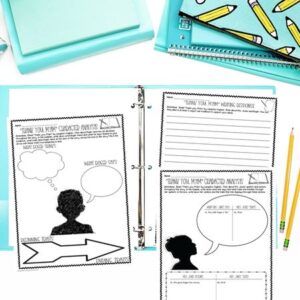
- Do you believe in second chances? What does the story say about second chances?
- How might the climax of the story also be seen as the turning point in Roger’s life?
- How would you describe Mrs. Luella Bates Washington Jones? Are her actions expected or unexpected in the story? Consider from Roger’s and the reader’s point of view.
Click to check out all of the details for this BUNDLE with differentiated options , which includes a Test Prep Quiz (with varied options), Venn Diagrams, Graphic Organizers, and Writing Responses!!
19. “Click Clack the Rattle Bag”
This short story by Neil Gaiman is creepy and fun in the best ways possible! The narrator is taking care of his girlfriend’s little brother and walking him to bed when the child asks for a story. Instead of the narrator sharing a story, the boy shares about the Click Clacks who drink their prey and leave behind rattling bodies. The end is too good to be missed!
Short stories and plots like those in “Click Clack the Rattle Bag” will most certainly engage even your most struggling learners!
- We all know that test prep can be tough as many reading passages are, well, boring! Why not accomplish some test prep with your students and incorporate 5 standardized test-related questions ? You could focus on theme, structure, order of events, characterization, etc.!
- Help students make inferences (acknowledging and hypothesizing about the impact of details that are not directly referenced or stated) as the scene moves along. Students can analyze the change in the setting, the little boy himself, the story the boy is telling, and specific phrases from the story.
- What details in the story contribute to its eerie atmosphere or mood? Or what figurative language devices does Neil Gaiman use to create a sense of suspense in the story?
- How does the author use ambiguity in the story? Is it effective or not? Explain.
- What inferences can you make about the relationship between the narrator and the young boy?

This “Click Clack the Rattle Bag” Quiz Pack for middle and high school students uses the Common Core standards and contains questions and answers modeled after various state standardized tests! Make teaching this amazing short story by Neil Gaiman SIMPLE & EASY!
Why should we incorporate more short stories and activities in our teaching?
While I would never advocate replacing all novels with short stories and smaller texts, there is still something to be said about spending quality time with short stories and excerpts.
Including short stories and standards-based activities is an ideal option to improve reading comprehension and develop skills, especially in middle and high school English classes!
SHORT STORIES AND ACTIVITIES RESOURCES:
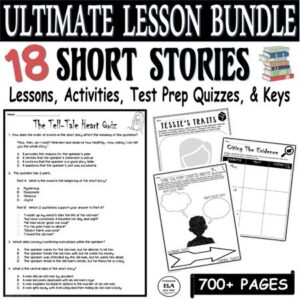
This Short Stories and Test Prep Questions ULTIMATE BUNDLE with Lessons, Quizzes, and Activities uses the Common Core standards with reading comprehension QUESTIONS and ANSWERS for 18 short stories such as “The Most Dangerous Game,” “The Monkey’s Paw,” “The Tell-Tale Heart,” “After Twenty Years,” “The Gift of the Magi,” “The Veldt,” “The Lottery,” “The Pedestrian,” etc. modeled after various state reading exams.
Make teaching short stories and activities SIMPLE & EASY!
Just PRINT & TEACH with engaging short stories and lessons!!
Need more fun ideas for teaching short stories and corresponding activities? Check out my store Kristin Menke-Integrated ELA Test Prep !

Hi, I’m KRISTIN!
I primarily focus on integrating multiple disciplines and subjects. The goal is to make teaching simplified and effective!
Let's Connect
- Follow Follow
Click below to download “13 Simple Strategies to make test prep a breeze!”
- Skip to primary navigation
- Skip to main content
- Skip to primary sidebar
Teaching Expertise
- Classroom Ideas
- Teacher’s Life
- Deals & Shopping
- Privacy Policy
Critical Thinking Activities For Middle Schoolers: PBL, Outdoor Ideas, Discussions, Games, And More
January 17, 2024 // by Lesa M.K. Bullins, EdS
Critical thinking is the process of using higher-order thinking skills in which students observe, conceptualize, apply, evaluate, and synthesize information that they learn in order to solve problems and make decisions effectively. Critical thinking is crucial for middle school students to be equipped to respond to academic, social, and emotional challenges successfully.
As an educator, developing critical thinking in students is paramount. Critical thinking skills are built through exploration, inquiry, questioning, discussion, and collaboration. Below are my top 20 classroom activities to transform your middle school students into critical thinkers!
1. Service Projects

Service projects support the development of global-mindedness in addition to building creativity, collaboration, and problem-solving. Service projects allow students the opportunity to engage their interests, apply learning to real-world situations, and actively problem-solve. Service projects could relate to classroom topics, holidays, or community areas in which students have concerns.
Learn More: Kid Activities
2. Project-Based Learning

Project-based learning builds creativity, collaboration, and problem-solving while creating opportunities for student motivation and engagement. You can learn about how to execute project-based learning here.
Learn More: PBL Works
3. Problem-Based Learning

The other “PBL” of education is problem-based learning. Problem-based learning activities are critical to the development of problem-solving skills. You can learn how to implement problem-based learning approaches here.
Learn More: Educators for Social Change
4. Get Outside the Classroom
Take learning outside the classroom. Applying learning to the world around them will support students in making crucial connections that build critical thinking. Check this video for ways to bring the outdoors to your classroom!
Learn More: Edutopia
5. Promote Inquiry

Inquiry-based learning is a cornerstone of critical thinking skills that creates in students an avid thinker of creative solutions. Instead of giving students the questions and then the answer, flip it! Give students information and have them build questions from their own thinking, or give students questions then allow them the space needed to find comprehensive solutions. Inquiry builds analytical skills.
Learn More: Taylor & Francis Online
6. Incorporate Turn and Talks
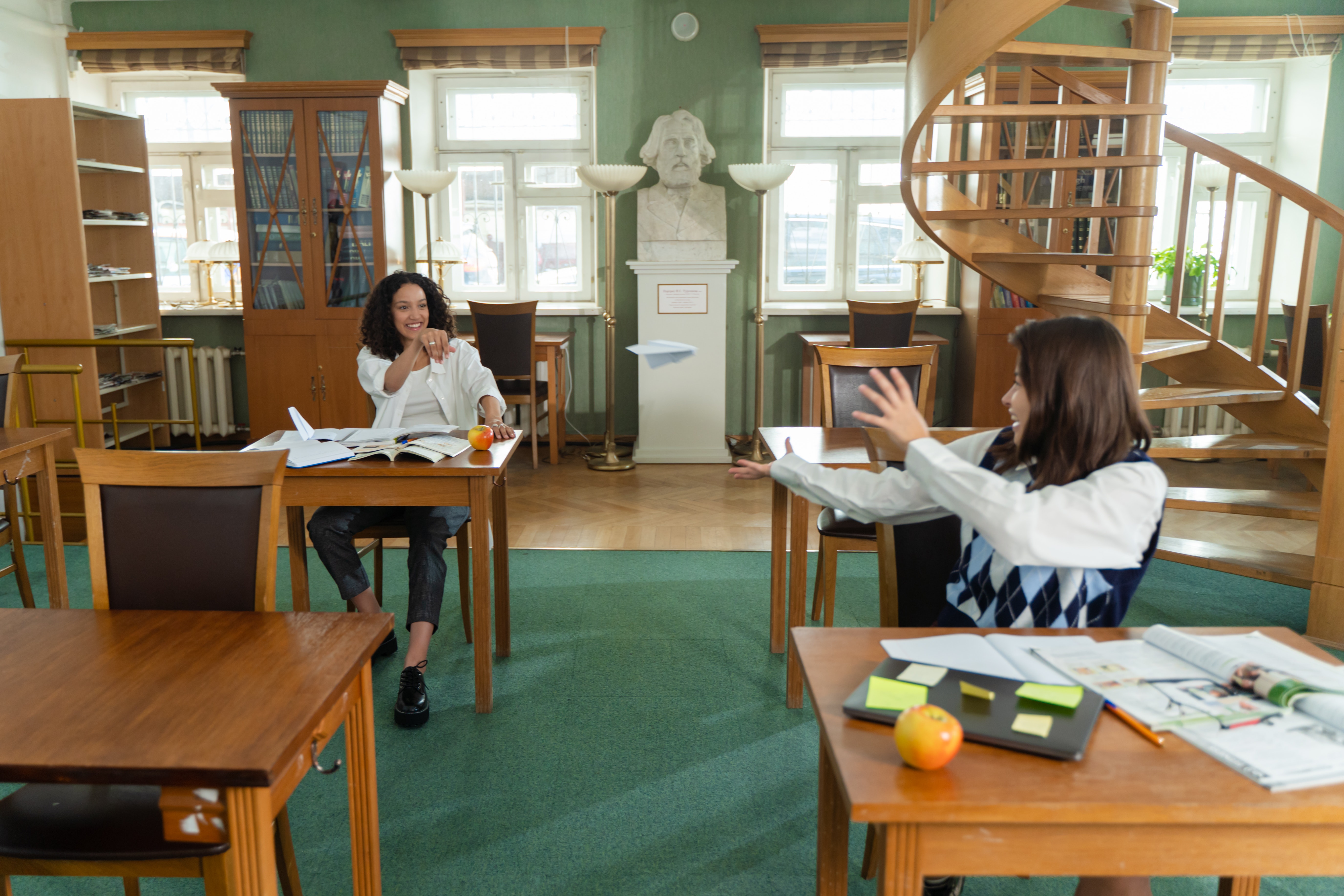
Turn and talks allow students to briefly share, review, and make connections to things they are learning. It is one of the top critical thinking resources when executed effectively in the classroom. Turn and talks allow for the exploration of an array of topics.
Learn More: Smekens Education and The Thinker Builder
7. Group Work Galore

While group work teaches cooperation, it also provides an opportunity for building critical thinking attributes like task deconstruction, planning, and explanation of thinking.
Learn More: Mrs. Spangler in the Middle
8. Bring Centers Back
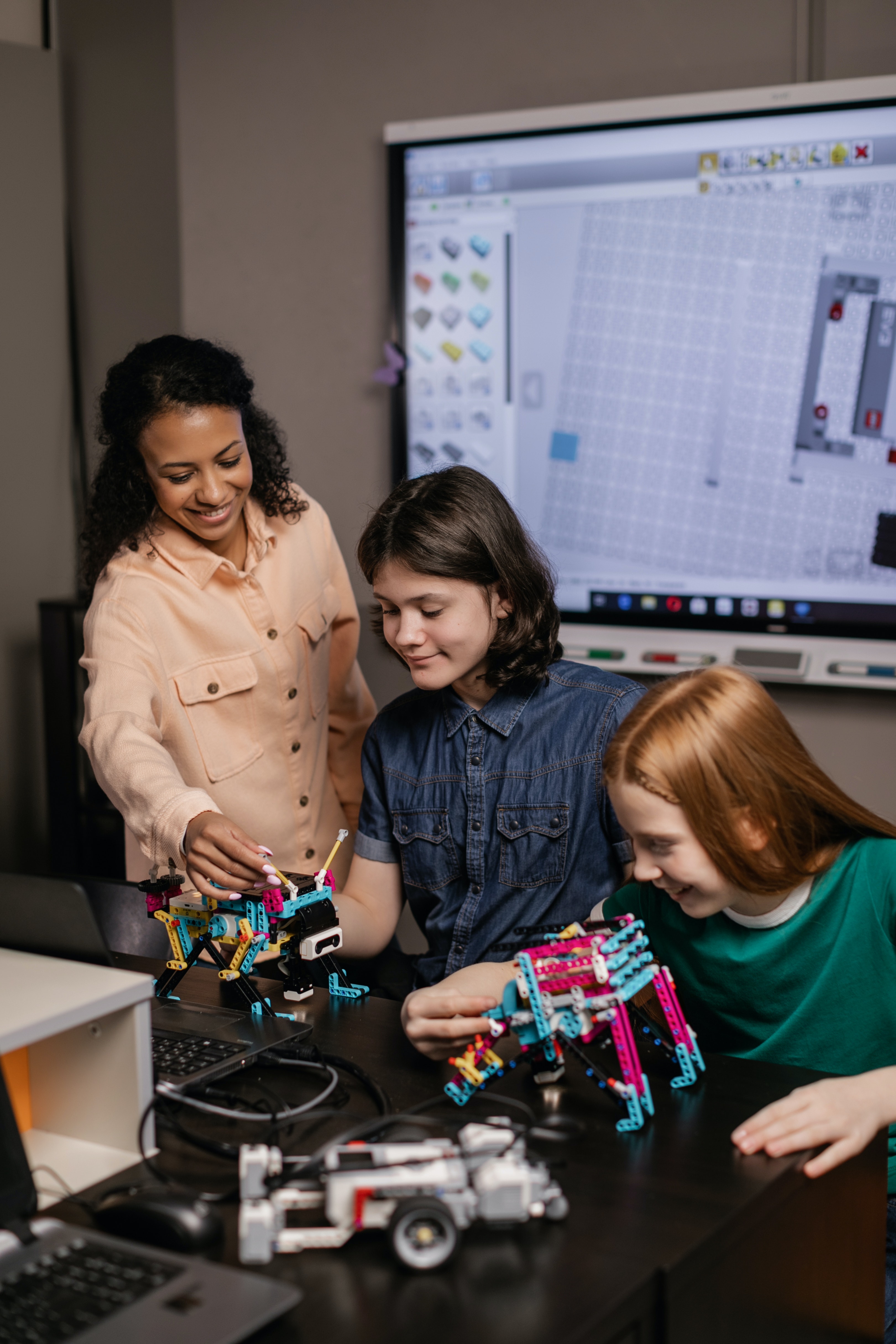
Centers are not just for elementary students. Centers create a diverse learning interaction that allows opportunities for students to be more expressive in the learning process. Critical thinking skills come out of such active learning. It is also a great way to leverage resources, especially teacher one-on-one time!
Learn More: Rachel Mccollum
9. Revive Reader’s Theatre

Using a reader’s theatre gives students a more enriching reading comprehension experience due to the highly engaging and interactive approach. Read more here about why you should use this reading approach to support critical thinking.
Learn More: Mrs. Beers
10. Hold Debates
Debate is an opportunity for individuals to consider, discuss, and analyze a controversial topic. Middle school students have ideas that they want to express and discuss. Giving them healthy opportunities for expression not only builds their critical thinking but also their confidence and sense of self.
11. Provide Creative Choices
Choice prompts critical thinking because it allows students to practice in a safe learning environment. Student choice can enhance the learning environment through deeper interest and engagement as well. Providing choice is a very effective opportunity for differentiation, and can even support metacognitive development.
Learn More: The Modern Classrooms Project
12. Promote Invention and Innovation

Creating inventions and innovations involved analyzing situations, considering outcomes, developing processes, and making connections to prior and related knowledge. Innovation and invention are essentially complete critical thinking activities.
Learn More: Invention and Education
13. Make Opportunities for Students to Teach
The deepest learning occurs when we teach others. Your kids will really be able to tap into their critical thinking skills in this exercise where you’ll invite them to play teacher! It’s a fantastic way to deepen their understanding of concepts as you’ll encourage them to reteach learning material to their peers.
Learn More: ASCD
14. Always Make Time for Reflection

Reflection is indispensable to the critical thinking process. Reflection empowers students as learners and prompts deeper thinking. Reflection allows students to tackle higher levels of thinking resulting in better consciousness of self and learning. You can provide opportunities for silent reflection, exit tickets, journals, etc.
Learn More: Responsive Classroom
15. Create Mysteries

Critical thinking hinges significantly on students interpreting, analyzing, and drawing conclusions. Mystery activities are exciting ways to engage these elements of critical thinking in a variety of subjects! Check out the example of a classroom mystery lesson here to inspire the use of mysteries in your own classroom subjects.
Learn More: Engaging Effective Teaching
16. Create Escape Rooms

It is not just mysteries that present logical thinking challenges and encompass the elements of critical thinking for practice in the classroom! Escape rooms are exceptional critical thinking activities. For some ideas on how to create escape rooms for different subjects in your class, check here.
Learn More: 23 Escape Room Games for Kids of All Ages
17. Prompt Class Discussions

Class discussions are the most naturally occurring critical thinking resources, so just harness the power by guiding and building skills for class discussion processes in your classroom. Class discussion fosters enhanced articulation, deep thinking, stronger connections to prior knowledge, deeper connections across content, and much more!
Learn More: University of Waterloo
18. Create a Job Board

Application of critical thinking skills in real-life scenarios like work is essential. Having classroom jobs is a practical way to put skills into practice. Classroom jobs can build a sense of community and responsibility in the classroom culture. I suggest using a job board approach and incentives for taking jobs such as free choice activities, extra time, etc. instead of assigned jobs. You can also make the job board a game similar to the popular Among Us game (minus the killing of course), to grab student interest.
Learn More: The Literary Maven
19. Encourage Habits of Mind
Habits of Mind are the same skills that make up the critical thinking concepts. Habits of Mind prompt analytical thinking, build strong learning habits, and sufficiently change patterns of thinking for students to truly become critical thinkers.
Learn More: Increasing Autonomy with Habits of Mind
20. Push a Growth Mindset
In conjunction with the skills of habits of mind, a growth mindset also presents students with an avenue to build lasting change in thinking patterns to become skillful critical thinkers. Students with a strong growth mindset have the power of resiliency. Resilience is a crucial aspect of critical thinking as it helps us to manage stress and adapt to change. Analyzing and solving problems requires adaptability.
Learn More: In Control Middle School SEL
10 Minute Critical Thinking Activities for English Classes
Hannah wahlig.

Critical thinking activities engage students' logic, rationality and judgment in problem-solving inquiries. English classes benefit from critical thinking activities because the activities activate students' prior knowledge, encourage creative thinking and stress the importance of evidence-based problem solving. Ten-minute critical thinking lessons serve as engaging and thought-provoking opening assignments that tune students in to the day's lessons.
Explore this article
- Logic Puzzles
- Judge and Jury
- Character Critique
1 Logic Puzzles
Simple logic puzzles require application of logic, reason and creativity to identify the correct answer. Riddles, brain teasers and logic games activate students' creative and critical minds and prepare them for a day of critical inquiry. Write a few brain teasers on the board; students immediately sit and begin to write down their answers. Sample brain teasers might include, "Do they have a Fourth of July in England?", "What is boiled then cooled before being sweetened and soured?" or "How many books can you put in an empty bag?" Include more difficult brain teasers for older students and simpler puzzles for younger students. Invite students to share and debate their answers before revealing the correct answer. See Resource 1 for a comprehensive list of brain teasers and logic puzzles.
2 Judge and Jury
Evaluation, analysis and judgment are all critical thinking skills that are particularly useful in an English classroom that requires close reading and analytical writing. Invite students to introduce to the class perceived injustices occurring in their school. Students may feel angry over a new dress code, a shortened lunch period or a new discipline policy. The student gives a one-minute summary of the problem and then has two minutes to prepare his best arguments against the infraction. Another student serves as a challenger and has two minutes to prepare her best arguments in support of the policy. The students each have one minute to present arguments. The class then votes on which student presented the best argument. If time permits, allow students to discuss why one set of arguments was more appealing than the other. The student debater who wins the class over receives a prize, such as extra points on an assignment.
3 Character Critique
Draw from the material used in the classroom to craft opening assignments that stimulate critical thinking. Select a character from the current text and ask students a series of analytical or self-reflective questions about the character. You might ask, "If this character were a student in our classroom, would you want to sit near her? Why or why not?" or "Would this character make a good friend? Partner? Parent? Why or why not?" Questions should require students to evaluate the characteristics of the character and apply them to real-life situations or contexts beyond the context of the book. Students share and debate their responses with the class.
About the Author
Hannah Wahlig began writing and editing professionally in 2001. Her experience includes copy for newspapers, journals and magazines, as well as book editing. She is also a certified lactation counselor. She holds a Bachelor of Arts in English from Mount Holyoke College, and Master's degrees in education and community psychology from the University of Massachusetts.
Related Articles

Fun Classroom Debate Games

Lunchtime Activities at School

How to Write Reading Comprehension Tests

Elements of Writing for Fifth Grade

Fun Writing Activities for Character Feelings for the...

Reasons for a Lost Emotional Connection

How to Restate an Expository Writing Prompt

Essay Topics for Third Graders

What Should You Include While Writing the Conclusion...

Lesson Plan on Subject-Verb Agreement for First Grade

What Is the Purpose of Classroom Assessments?

What Is the Difference Between AP English Literature...

Reading Comprehension and Main Ideas Practice for Adults

Ways to Introduce a Short Story to High School Students

High School Homeroom Activities

Warm-Up Activities for English Class

How to Write About an Ethical Dilemma

Summarizing Activities for Nonfiction

What Is the Difference Between Portfolio Assessment...

Effective Teaching Strategies for Prose
Regardless of how old we are, we never stop learning. Classroom is the educational resource for people of all ages. Whether you’re studying times tables or applying to college, Classroom has the answers.
- Accessibility
- Terms of Use
- Privacy Policy
- Copyright Policy
- Manage Preferences
© 2020 Leaf Group Ltd. / Leaf Group Media, All Rights Reserved. Based on the Word Net lexical database for the English Language. See disclaimer .
- Grades 6-12
- School Leaders
Get our FREE Classroom Seating Charts 🪑
5 Critical Thinking Skills Every Kid Needs To Learn (And How To Teach Them)
Teach them to thoughtfully question the world around them.

Little kids love to ask questions. “Why is the sky blue?” “Where does the sun go at night?” Their innate curiosity helps them learn more about the world, and it’s key to their development. As they grow older, it’s important to encourage them to keep asking questions and to teach them the right kinds of questions to ask. We call these “critical thinking skills,” and they help kids become thoughtful adults who are able to make informed decisions as they grow older.
What is critical thinking?
Critical thinking allows us to examine a subject and develop an informed opinion about it. First, we need to be able to simply understand the information, then we build on that by analyzing, comparing, evaluating, reflecting, and more. Critical thinking is about asking questions, then looking closely at the answers to form conclusions that are backed by provable facts, not just “gut feelings” and opinion.
Critical thinkers tend to question everything, and that can drive teachers and parents a little crazy. The temptation to reply, “Because I said so!” is strong, but when you can, try to provide the reasons behind your answers. We want to raise children who take an active role in the world around them and who nurture curiosity throughout their entire lives.
Key Critical Thinking Skills
So, what are critical thinking skills? There’s no official list, but many people use Bloom’s Taxonomy to help lay out the skills kids should develop as they grow up.

Source: Vanderbilt University
Bloom’s Taxonomy is laid out as a pyramid, with foundational skills at the bottom providing a base for more advanced skills higher up. The lowest phase, “Remember,” doesn’t require much critical thinking. These are the skills kids use when they memorize math facts or world capitals or practice their spelling words. Critical thinking doesn’t begin to creep in until the next steps.
Understanding requires more than memorization. It’s the difference between a child reciting by rote “one times four is four, two times four is eight, three times four is twelve,” versus recognizing that multiplication is the same as adding a number to itself a certain number of times. Schools focus more these days on understanding concepts than they used to; pure memorization has its place, but when a student understands the concept behind something, they can then move on to the next phase.
Application opens up whole worlds to students. Once you realize you can use a concept you’ve already mastered and apply it to other examples, you’ve expanded your learning exponentially. It’s easy to see this in math or science, but it works in all subjects. Kids may memorize sight words to speed up their reading mastery, but it’s learning to apply phonics and other reading skills that allows them to tackle any new word that comes their way.
Analysis is the real leap into advanced critical thinking for most kids. When we analyze something, we don’t take it at face value. Analysis requires us to find facts that stand up to inquiry, even if we don’t like what those facts might mean. We put aside personal feelings or beliefs and explore, examine, research, compare and contrast, draw correlations, organize, experiment, and so much more. We learn to identify primary sources for information, and check into the validity of those sources. Analysis is a skill successful adults must use every day, so it’s something we must help kids learn as early as possible.
Almost at the top of Bloom’s pyramid, evaluation skills let us synthesize all the information we’ve learned, understood, applied, and analyzed, and to use it to support our opinions and decisions. Now we can reflect on the data we’ve gathered and use it to make choices, cast votes, or offer informed opinions. We can evaluate the statements of others too, using these same skills. True evaluation requires us to put aside our own biases and accept that there may be other valid points of view, even if we don’t necessarily agree with them.
In the final phase, we use every one of those previous skills to create something new. This could be a proposal, an essay, a theory, a plan—anything a person assembles that’s unique.
Note: Bloom’s original taxonomy included “synthesis” as opposed to “create,” and it was located between “apply” and “evaluate.” When you synthesize, you put various parts of different ideas together to form a new whole. In 2001, a group of cognitive psychologists removed that term from the taxonomy , replacing it with “create,” but it’s part of the same concept.
How To Teach Critical Thinking
Using critical thinking in your own life is vital, but passing it along to the next generation is just as important. Be sure to focus on analyzing and evaluating, two multifaceted sets of skills that take lots and lots of practice. Start with these 10 Tips for Teaching Kids To Be Awesome Critical Thinkers . Then try these critical thinking activities and games. Finally, try to incorporate some of these 100+ Critical Thinking Questions for Students into your lessons. They’ll help your students develop the skills they need to navigate a world full of conflicting facts and provocative opinions.
One of These Things Is Not Like the Other
This classic Sesame Street activity is terrific for introducing the ideas of classifying, sorting, and finding relationships. All you need are several different objects (or pictures of objects). Lay them out in front of students, and ask them to decide which one doesn’t belong to the group. Let them be creative: The answer they come up with might not be the one you envisioned, and that’s OK!
The Answer Is …
Post an “answer” and ask kids to come up with the question. For instance, if you’re reading the book Charlotte’s Web , the answer might be “Templeton.” Students could say, “Who helped save Wilbur even though he didn’t really like him?” or “What’s the name of the rat that lived in the barn?” Backwards thinking encourages creativity and requires a good understanding of the subject matter.
Forced Analogies

Practice making connections and seeing relationships with this fun game. Kids write four random words in the corners of a Frayer Model and one more in the middle. The challenge? To link the center word to one of the others by making an analogy. The more far out the analogies, the better!
Learn more: Forced Analogies at The Owl Teacher
Primary Sources
Tired of hearing “I found it on Wikipedia!” when you ask kids where they got their answer? It’s time to take a closer look at primary sources. Show students how to follow a fact back to its original source, whether online or in print. We’ve got 10 terrific American history–based primary source activities to try here.
Science Experiments

Hands-on science experiments and STEM challenges are a surefire way to engage students, and they involve all sorts of critical thinking skills. We’ve got hundreds of experiment ideas for all ages on our STEM pages , starting with 50 Stem Activities To Help Kids Think Outside the Box .
Not the Answer
Multiple-choice questions can be a great way to work on critical thinking. Turn the questions into discussions, asking kids to eliminate wrong answers one by one. This gives them practice analyzing and evaluating, allowing them to make considered choices.
Learn more: Teaching in the Fast Lane
Correlation Tic-Tac-Toe

Here’s a fun way to work on correlation, which is a part of analysis. Show kids a 3 x 3 grid with nine pictures, and ask them to find a way to link three in a row together to get tic-tac-toe. For instance, in the pictures above, you might link together the cracked ground, the landslide, and the tsunami as things that might happen after an earthquake. Take things a step further and discuss the fact that there are other ways those things might have happened (a landslide can be caused by heavy rain, for instance), so correlation doesn’t necessarily prove causation.
Learn more: Critical Thinking Tic-Tac-Toe at The Owl Teacher
Inventions That Changed the World
Explore the chain of cause and effect with this fun thought exercise. Start it off by asking one student to name an invention they believe changed the world. Each student then follows by explaining an effect that invention had on the world and their own lives. Challenge each student to come up with something different.
Learn more: Teaching With a Mountain View
Critical Thinking Games

There are so many board games that help kids learn to question, analyze, examine, make judgments, and more. In fact, pretty much any game that doesn’t leave things entirely up to chance (Sorry, Candy Land) requires players to use critical thinking skills. See one teacher’s favorites at the link below.
Learn more: Miss DeCarbo
This is one of those classic critical thinking activities that really prepares kids for the real world. Assign a topic (or let them choose one). Then give kids time to do some research to find good sources that support their point of view. Finally, let the debate begin! Check out 100 Middle School Debate Topics , 100 High School Debate Topics , and 60 Funny Debate Topics for Kids of All Ages .
How do you teach critical thinking skills in your classroom? Come share your ideas and ask for advice in the WeAreTeachers HELPLINE group on Facebook .
Plus, check out 38 simple ways to integrate social-emotional learning throughout the day ..

You Might Also Like

10 Tips for Teaching Kids To Be Awesome Critical Thinkers
Help students dig deeper! Continue Reading
Copyright © 2024. All rights reserved. 5335 Gate Parkway, Jacksonville, FL 32256
Want a daily email of lesson plans that span all subjects and age groups?
Subjects all subjects all subjects the arts all the arts visual arts performing arts value of the arts back business & economics all business & economics global economics macroeconomics microeconomics personal finance business back design, engineering & technology all design, engineering & technology design engineering technology back health all health growth & development medical conditions consumer health public health nutrition physical fitness emotional health sex education back literature & language all literature & language literature linguistics writing/composition speaking back mathematics all mathematics algebra data analysis & probability geometry measurement numbers & operations back philosophy & religion all philosophy & religion philosophy religion back psychology all psychology history, approaches and methods biological bases of behavior consciousness, sensation and perception cognition and learning motivation and emotion developmental psychology personality psychological disorders and treatment social psychology back science & technology all science & technology earth and space science life sciences physical science environmental science nature of science back social studies all social studies anthropology area studies civics geography history media and journalism sociology back teaching & education all teaching & education education leadership education policy structure and function of schools teaching strategies back thinking & learning all thinking & learning attention and engagement memory critical thinking problem solving creativity collaboration information literacy organization and time management back, filter by none.
- Elementary/Primary
- Middle School/Lower Secondary
- High School/Upper Secondary
- College/University
- TED-Ed Animations
- TED Talk Lessons
- TED-Ed Best of Web
- Under 3 minutes
- Under 6 minutes
- Under 9 minutes
- Under 12 minutes
- Under 18 minutes
- Over 18 minutes
- Algerian Arabic
- Azerbaijani
- Cantonese (Hong Kong)
- Chinese (Hong Kong)
- Chinese (Singapore)
- Chinese (Taiwan)
- Chinese Simplified
- Chinese Traditional
- Chinese Traditional (Taiwan)
- Dutch (Belgium)
- Dutch (Netherlands)
- French (Canada)
- French (France)
- French (Switzerland)
- Kurdish (Central)
- Luxembourgish
- Persian (Afghanistan)
- Persian (Iran)
- Portuguese (Brazil)
- Portuguese (Portugal)
- Spanish (Argentina)
- Spanish (Latin America)
- Spanish (Mexico)
- Spanish (Spain)
- Spanish (United States)
- Western Frisian
sort by none
- Longest video
- Shortest video
- Most video views
- Least video views
- Most questions answered
- Least questions answered

How could so many people support Hitler?
Lesson duration 05:10
577,604 Views

Can you solve the magical maze riddle?
Lesson duration 04:51
434,997 Views

How to make smart decisions more easily
Lesson duration 05:16
1,268,189 Views

Can you solve a mystery before Sherlock Holmes?
Lesson duration 05:17
509,794 Views

Can you solve the secret assassin society riddle?
Lesson duration 05:01
840,186 Views

How to overcome your mistakes
Lesson duration 04:52
967,986 Views

Can you solve the cursed dice riddle?
Lesson duration 04:31
772,115 Views

Why some people don't have an inner monologue
Lesson duration 12:03
2,857,070 Views

Science vs. Pseudoscience
Lesson duration 05:48
358,851 Views

Can you solve the time traveling car riddle?
Lesson duration 05:18
675,880 Views

This one weird trick will get you infinite gold
Lesson duration 05:08
1,126,406 Views

How to quit your job — without ruining your career - Gala Jackson
Lesson duration 06:13
111,786 Views

What if you experienced every human life in history?
Lesson duration 05:21
2,974,883 Views

How to design climate-resilient buildings - Alyssa-Amor Gibbons
Lesson duration 14:12
45,400 Views

The case for free, universal basic services - Aaron Bastani
Lesson duration 19:09
81,312 Views

Can you steal the most powerful wand in the wizarding world?
Lesson duration 05:20
806,663 Views

History vs. Thomas Jefferson
482,946 Views

The best way to apologize (according to science)
Lesson duration 05:06
1,519,473 Views

How do we determine the value of a life?
Lesson duration 06:06
772,559 Views

What’s the smartest age?
Lesson duration 04:53
1,653,704 Views

The Boltzmann brain paradox
Lesson duration 05:40
1,193,822 Views

The 4 greatest threats to the survival of humanity
Lesson duration 05:24
491,474 Views

Can you outsmart the college admissions fallacy?
Lesson duration 06:17
831,943 Views

Can you solve the fortress riddle?
Lesson duration 05:23
1,278,603 Views

- Join our Team
- Online Platform Tutorial
- TEFL Courses
- Contact Us / FAQ
Forgot Username or Password
- Active vs. Passive Voice
- Adverbial Clauses
- Adverbial Phrases
- Be Going To Statements
- Be Going To Wh Questions
- Be Going To Yes/No Questions
- Be Going To & Present Continuous
- Comparatives
- Superlatives
- Comparatives & Superlatives
- Zero Conditional
- First Conditional
- Second Conditional
- Third Conditional
- Mixed Conditionals
- Future Continuous
- Future Continuous vs. Future Perfect
- Future Perfect Continuous
- Future Perfect Simple
- Future Simple
- Future Tenses
- Future Time Clauses
- Gerunds & Infinitives
- Have Got & Has Got
- I wish & If only
- Imperatives
- Irregular Verbs
- Narrative Tenses
- Noun Clauses
- Noun Phrases
- Passive Voice
- Past Continuous
- Past Perfect
- Past Perfect Continuous
- Past Perfect Simple & Continuous
- Past Simple Affirmative & Negative
- Past Simple Passive
- Past Simple Regular Verbs
- Past Simple Was and Were
- Past Simple Wh Questions
- Past Simple Yes/No Questions
- Past Simple vs. Past Continuous
- Past Simple vs. Present Perfect
- Past Tense Review
- Present Continuous
- Present Perfect
- Present Perfect Continuous
- Present Perfect - Ever and Never
- Present Perfect - For and Since
- Present Perfect - Just, Yet & Already
- Present Simple Affirmative & Negative
- Present Simple Passive
- Present Simple vs. Present Continuous
- Present Simple vs. Present Perfect
- Present Simple Wh Questions
- Present Simple Yes/No Questions
- Present Tense Review
- Question Words
- Relative Clauses
- Reported Speech
- Subject-Verb Agreement
- Tag Questions
- There is & There are
- Wh Questions
- Abstract Nouns
- Adjective-Noun Collocations
- Adjectives of Feeling & Emotion
- Adjectives of Opinion
- Adjectives of Quantity
- Adjective Opposites
- Adjective Order
- Adjective-Preposition Collocations
- -ed and -ing Adjectives
- Adverb-Adjective Collocations
- Adverb Order
- Adverbs of Affirmation & Negation
- Adverbs of Degree
- Adverbs of Frequency
- Adverbs of Manner
- Adverbs of Place
- Adverbs of Time
- Articles - a, an, the
- Causative Verbs
- Collective Nouns
- Common & Proper Nouns
- Compound Adjectives
- Compound Nouns
- Concrete Nouns
- Conjunctions
- Countable & Uncountable Nouns
- Demonstrative Adjectives
- Demonstrative Pronouns
- Dependent Prepositions
- Indefinite Pronouns
- Intensifiers & Mitigators
- Interjections
- Modal Verbs of Ability
- Modals of Deduction & Speculation
- Modals of Necessity
- Modals of Obligation & Prohibition
- Modals of Possibility & Certainty
- Onomatopoeia
- Parts of Speech
- Phrasal Verbs
- Possessives
- Prepositions of Movement
- Prepositions of Place
- Prepositions of Time
- Proper Adjectives
- Quantifiers
- Reflexive Pronouns
- Sense Verbs and Adjectives
- Singular & Plural Nouns
- So and Such
- Subject & Object Pronouns
- Too and Enough
- Transition Words
- Verb-Noun Collocations
- Agreeing & Disagreeing
- Asking Permission
- At the Dentist's
- At the Doctor's
- Being Polite
- Classroom Language
- Complaining & Apologizing
- Complimenting
- Critical Thinking & Problem Solving
- Describing Character & Personality
- Describing People's Appearance
- Describing Places
- Describing Things
- Etiquette and Manners
- Getting Around
- Getting to Know You
- Giving Advice
- Giving Directions
- Giving Opinions
- Giving Personal Information
- Greetings & Introductions
- Indirect Questions
- Likes and Dislikes
- Making Arrangements
- Making Decisions
- Making Excuses
- Making Invitations
- Making Offers & Promises
- Making Requests
- Making Suggestions
- Online Communication
- Ordering Food & Drink
- Social Media
- Telephoning
- Times and Dates
- British English vs. American English
- Cities, Towns & Places
- Clothes & Fashion
- Computers & Smartphones
- Countries & Nationalities
- Crime, Law & Punishment
- Cultural Celebrations
- Daily Routines
- Everyday Obects
- Family & Relationships
- Food & Drink
- Going Out & Entertainment
- Health & Fitness
- Hobbies & Free Time
- Houses, Rooms & Furniture
- Jobs & the Workplace
- Love, Romance & Dating
- Modes of Transport
- Parts of the Body
- Reading Comprehension
- Shapes & Measurements
- The Natural World
- Time Expressions
- TV & Film
- Valentine's Day
- Academic Collocations
- Academic Phrasal Verbs
- Academic Reading Comprehension
- AWL Sublist 1 & 2
- Cause and Effect Essays
- Compare and Contrast Essays
- Discussion Essays
- Discussion Skills
- Discussions Practice
- Essay Writing
- Paragraph Writing
- Persuasive Essays
- Presentation Skills
- Problem Solution Essays
- Punctuation
- Reading Skills
- Referenced Essays
- Study Skills
- The Writing Process
- Business Collocations
- Business Emails
- Business Idioms
- Business Meetings
- Business Negotiations
- Business Phrasal Verbs
- Closing a Presentation
- Describing Graphs & Charts
- Presentation Language & Structure
- Resumes, CVs & Email Cover Letters
- Starting a Presentation
- Talking About Jobs
- Answer Games
- Brainstorming Games
- Category Games
- Classic Childhood Games
- Counting Games
- Describing Games
- Drawing Games
- Drilling Activity Games
- First Day of Class Games
- Flashcard Games
- Grammar Games
- Hangman Games
- Listening Games
- Miming Games
- Music Games
- Question & Answer Games
- Sentence Race Games
- Spelling Games
- TV Game Shows
- Vocabulary Games
- Word Association Games
- Yes/No Question Games
- Classroom Interaction Patterns
- Classroom Management
- Concept Checking
- Cultural Awareness
- Developing Students' Listening Skills
- Developing Students' Reading Skills
- Developing Students' Speaking Skills
- Eliciting Techniques
- ESL Dictations
- How to Introduce a Lesson
- How to Use Music in ESL Class
- Lesson Planning
- Making Teaching Materials Relevant
- Problems Learning English
- Teaching English Idioms
- Teaching English Vocabulary
- Teaching Large Classes
- Teaching Mixed-Ability Classes
- Teaching Small Classes
- The First Day of Class
- Using Correction in Class
- Using Song Gap Fills
- Online Membership
- ESL Essentials eBook Series
Critical Thinking and Problem Solving ESL Activities, Games and Lessons
- Intermediate ( B1 )
- Upper-intermediate ( B2 )
- Advanced ( C1 )

What makes you happy?
Esl happiness activity - speaking: listing, guided discussions, categorising, freer practice - pair and group work - intermediate (b1) - 40 minutes.

Island Adventure
Esl desert island survival game - reading, writing, listening and speaking activity: writing sentences, preparing and delivering a presentation - group work - upper-intermediate (b2) - 60 minutes.
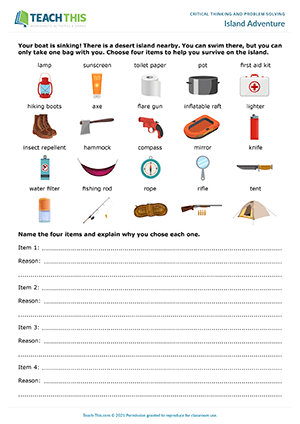
My Ideal Partner
Esl critical thinking activity - speaking: asking and answering questions, expressing opinions, negotiating, ranking, communicative practice - pair work - upper-intermediate (b2) - 25 minutes.
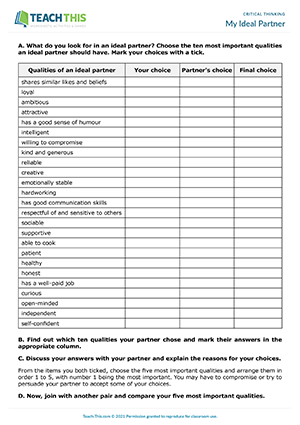
ESL Stress Activity - Speaking: Asking and Answering Questions, Guided Discussion, Ranking, Survey, Poster Creation, Freer and Communicative Practice - Pair and Group Work - Upper-intermediate (B2) - 90 minutes

ESL Critical Thinking Lesson - Reading and Listening Exercises: Answering Questions, Song Gap-fill, Answering Questions - Speaking Activity: Discussion - Group Work - Upper-intermediate (B2) - 90 minutes
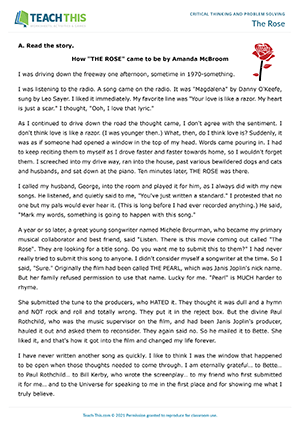
What's the criteria?
Esl critical thinking and problem-solving activity - speaking: ranking, guided discussion, guessing, communicative practice - group work - upper-intermediate (b2) - 30 minutes.
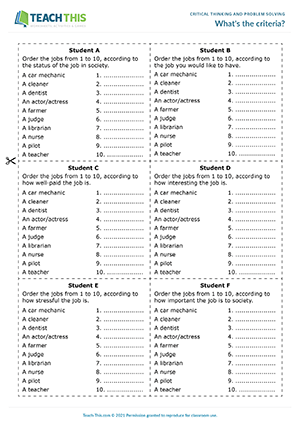
ESL Critical Thinking Activity - Speaking: Guided Discussion, Communicative Practice - Group Work - Upper-intermediate (B2) - 30 minutes
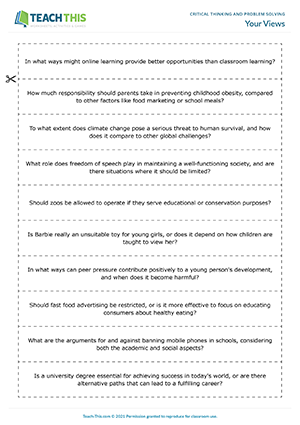
ESL Problem Solving Activity - Speaking: Guided Discussion, Presenting, Preparing and Performing a Role-Play, Communicative Practice - Group Work - Advanced (C1) - 40 minutes
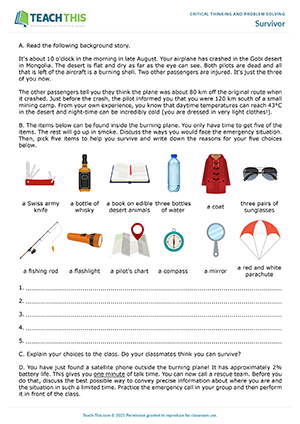
Zero Sum Negotiations
Esl zero sum negotiations activity - speaking: negotiating, discussion, communicative practice - pair work - writing exercise: answering questions - advanced (c1) - 40 minutes.
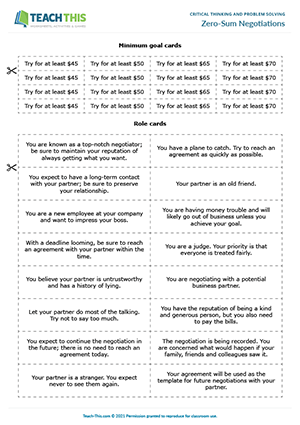
New Teaching Resources eBooks
Now Available!
Get Started Here
https://www.teach-this.com/esl-essentials
LATEST FREE RESOURCES
- Everyday Objects
Elementary (A1-A2)
Upper-intermediate (B2)
LATEST MEMBER RESOURCES
Modal verbs of obligation and prohibition.
Pre-intermediate (A2)

Here's what our members are saying...
There are a lot of resources that are useful for teaching English. I downloaded the games which are handy and use them in my classes. With the games, my students never skip class or feel tired to learn English. The resources for teaching English helped my students progress in grammar, vocabulary, writing and comprehension. They also helped me a lot to guide my students to learn in a practical way.
I like the efficiency and organization of the website. The resources cater to various levels with topic-based options for higher levels. The worksheets are very engaging and the answer keys are particularly helpful for teacher. The resources are also highly specific to levels and outcomes, making planning much easier. Finding what I need is simple and time-saving with the keyword search feature. Everything is clear and straightforward.
The easy and ready-to-go materials have helped me a lot during the last few years. Most of all I like the grammar games that activate my pupils and keep them engaged. My lessons have become way more playful and varied. Additionally, I like the grammar worksheets which I use to consolidate what I have worked on during class. The website is very user-friendly, and I have never had any difficulties finding what I was looking for.
A friend told me about the site, and it's awesome. I have found the Business English resources especially engaging and relevant for my students as the materials help them understand business writing and terms. My teaching experience has also improved from using the games on the site as they allow me to teach in a fun way. The user experience is outstanding. Great job!
I found Teach-This a long time ago when I started teaching. It's always had great resources. I really appreciate the grammar materials, board games, and group activities. They've saved me lots of time on lesson planning. The materials are easy to use and understand, making my job much simpler. The best thing is that many resources can be downloaded for free. I've used it for around 8 years, and it consistently offers great content.
I use the resources from the Games Section as part of my daily 30-minute morning warm-up activities, and I've received rave reviews for using them. The games help me maintain student interest and participation and leave the students feeling happy and awake. I like everything about the site, and customer support is very effective as they respond in time.
Teach-This is one of the best EFL websites I've found. It's extremely user-friendly, and I always find what I need quickly. I like the design, and the content is fun, engaging and original. I am very thankful for all your work and generosity by making some resources free. I always recommend this website to my fellow teachers. Your work is really helpful, and I value it enormously.
I like the grammar-focused resources the most as they save me time. The resources also inspire me. If I see an interesting grammar activity, I often rework it for other grammar rules. I like the fact that I simply pay a flat fee, and I can download whatever I want. Teach-This really is a great timesaver. I know that if I am in need of resources for my students, I can go to Teach-This and find something interesting.
Getting familiar with the site and how to use the resources is not difficult. I found the writing skills resources to be the most valuable as they have enhanced my teaching of this skill. The website is elaborate and full of all types of resources to help me teach English. When I contacted customer support, they were super-fast to deal with my enquiry. So overall, I recommend it.
I have found the grammar and vocabulary resources the most valuable. They have improved my teaching experience because they are easy to use and well-organized. The materials are very engaging for my students. The website is also very user-friendly. The best thing about Teach-This is that it offers ready-made worksheets for busy teachers, and the content is well-organized and full of information.
I'm really glad I found the Teach-This website. The materials in the General English section have proven to be really helpful and made my classes more engaging. The materials are well-structured and cover a wide range of topics, making it easy to keep my students interested and motivated. Overall, my experience using your resources has been great.
My first impression of the website was that it was amazing. The games and activities have really improved my teaching. The resources are engaging and relevant to my students’ needs, and I find the website easy to use and navigate. Thanks.
I discovered the site on Google when I was searching for question games and reading activities. It has been very helpful. The activities are awesome and have benefited me and my students by making my classes more fun. I am now less stressed about preparing for classes as the ready-made resources offer me everything I need. I give the site five out of five for user-friendliness. It is very easy to navigate and find what I need.
I would like to thank you for making a fantastic website. I particularly enjoy teaching the functional language materials, which have been very helpful in my classes. The resources have significantly improved my students' communication skills in daily life, so it was rewarding to see them benefit in this way. It feels great to be able to make a difference in my students' lives. Please keep up the good work.
- Have got & Has got
- Adverbs of Affirmation and Negation
- Concrete nouns
- Sense Verbs & Adjectives
- AWL Sublist 1 and 2
- Talking about Jobs
- TEFL Certification & Courses
- Privacy Policy
- Terms of Use
elttguide.com
- Premium Content
- Publications
- Lesson Plans


40 Activities For Developing Critical Thinking in EFL Classes

In this article, I’m going to tackle critical thinking; what it is, what it involves, and some practical activities to develop it in EFL classes.
Critical thinking is one of the main purposes of education. Teachers should prepare their students to think critically from the first day of school. Critical thinking helps students to lead successful, fulfilling lives and become engaged citizens.
What Is Meant By Critical Thinking?
In today’s world, critical thinking is:
- The ability to think about one’s thinking to recognize and improve it.
- The process of applying, analyzing, constructing and evaluating information.
- Making reasoned judgments using certain criteria to judge the quality of something.
What Critical Thinking Involves?
- Asking questions,
- Defining a problem,
- Examining evidence,
- Analyzing assumptions and biases,
- Avoiding emotional reasoning,
- Avoiding oversimplification,
- Considering all interpretations,
- Using higher level thinking skills; analyzing, evaluating and
- Reaching creative solutions for problems.
Why Teach Critical Thinking?
Teachers should focus mainly to develop their students’ critical thinking to help them:
- Be active receptors of the massive information that they receive nowadays.
- Solve the complex problems that they face every day.
- Make sound decisions about personal and civic affairs.
The Main Teaching Strategies To Develop Critical Thinking
- Using ongoing classroom assessment.
- Putting students in group learning situations to get continuous support and feedback from other students.
- Presenting case studies to the class without a conclusion and using discussion and debate methods.
- Using critical questions.
- Using dialogues written or oral and encouraging students to analyze them.
- Using comparisons to show the pros and cons of two things.
Example #1 of a Critical Thinking Activity
Using debates
Letter x Email
Broom x Vacuum cleaner
Telephone (landline) x Cell phone
Oven x Microwave
Sponge and soap x Dishwasher
Candle x Bulb
Book x Kindle
1. Ask the class who, in their own opinion, wins and why?
2. Ask students to pretend to be the item that they choose, try to list its advantages, and debate them with the other student.
3. Ask students to act out what they prepared in front of the class.
4. Ask the class to listen and take notes.
Example #2 of a Critical Thinking Activity
Using short stories
Ask students to read the following short story and answer the questions below:
Just before Christmas my father took me skiing at Mount Baker. He’d had to fight for the privilege of my company, because my mother was still angry with him for sneaking me into a nightclub during his last visit, to see Thelonious Monk.
- Write an introduction to this short story.
- Write the second paragraph.
- Do you think they stayed up all night in the nightclub? What did they do?
- What do you think about the father?
- Do you think the family enjoyed Christmas?
- If you were the mother, would you be angry?
- What did you learn from the story?
- Can you guess the best/worst case scenario of how the story will end?
- Why did the father take the kid to the nightclub?
- Do you think the mother wanted to go to the nightclub?
- Do you like such a father?
- Do you think the dad lives with the family?
- What are the feelings of the kid?
- Do you think the kid has siblings?
- Did the kid solve the problem with his mother?
- What would you do if you were in his/her shoes?
- How old is he or she?
- Where do they live? Country or town?
- Do you think the kid is good at school?
- Why did the father sneak the kid into the nightclub?
- Do you think the mother was right when she got angry?
- What do you think of the dad?
- Should the kid apologize to the mother and how?
- Does the father accompany his kid often or rarely?
- What do you think happened before Christmas?
- Why did the father not take the mother along? …. etc.
When asking students such critical thinking questions, the teacher should:
- Keep the discussion focused.
- Keep the discussion reasonable.
- Stimulate the discussion with more probing questions.
- Summarize periodically what has and what has not been dealt with or resolved.
- Engage as many students as possible in the discussion.
More Examples of Activities For Developing Critical Thinking in EFL Classes
3. Write a title on the board, divide the students into groups, and they sit together and make a story (each group will have a different story and then share it with the whole class).
4. Use a short story, ask students about their opinions of the characters, then discuss with the whole class whether they agree or disagree asking why?
5. Draw objects and ask them about them (compare and contrast).
6. Write an essay on a certain topic or respond to an email.
7. Suggest a suitable title for a story.
8. Transfer information to others
9. Brainstorm ideas using a mind map.
10. Summarize a text and give opinions.
11. Ask what-if questions (what if you were Oliver twist/Cinderella).
12. Ask students to complete a sentence.
13. Ask about the moral of a story.
14. Give students a problem related to their environment and ask them to do research about it and give some creative solutions for it.
15. Ask open-ended questions; questions that have many possible answers (e.g. should we spend more money developing earth or exploring space?). Divide the class into groups, each thinks of answers and then shares them.
16. Give a situation and encourage students (in groups) to analyze, evaluate, and make judgments.
17. Ask students to make an end to a story.
18. Ask students to criticize a certain situation.
19. List the advantages and disadvantages of a topic.
20. Introduce some situations using (what would you do in the following situation? what if we do not have …., what would happen if …?
21. Ask students: which is different: milk, water, soda, or juice? Why? Which one is better (in pairs and students pick different sides)
22. Imagine you are the president, the mayor, a leader, a doctor etc… What decisions would you take first?
Reading Activities
Let’s brainstorm some ideas of how to promote critical thinking after reading a story, e.g. “Cinderella”.
23. Analyze characters: Do you like “Character”? Why?
24. Use what-if questions: What if Cinderella was ugly?
25. Introduce or remove a character then ask for the impact on the storyline.
26. Ask for another ending for the story.
27. Ask for their thoughts about what’s after the ending.
28. Change the setting and ask for the results.
29. Ask students to watch the movie after reading the story and then compare the characters and the storyline!
Speaking activities
30. Ask students to look at a certain picture and describe their feelings about it.
31. Ask students to compare things.
32. Introduce a problem and ask students to give as many solutions as possible for it.
33. Ask students to gather information from conflicting resources.
34. Ask controversial questions.
35. Encourage Role Plays.
36. Ask students about their priority: education/health/entertainment and why?
Listening activities
37. Prediction.
38. Making inferences.
39. Drawing conclusions.
40. Differentiating between facts and opinions.
Writing Activities
41. Writing blurbs to pictures or ads … etc.
42. Writing Commentaries.
43. Responding to emails, letters or SMS.
For setting students up for success in critical thinking activities teachers need to:
- Brainstorm enough information before asking students to carry out a certain task.
- Encourage them to participate.
- Provide them with help and guidance (when needed).
- Assure them that there are no “wrong answers”.
- Accept all answers and points of view.
- Appreciate their efforts.
- Praise their trials.
- Teach them critical thinking skills!
Here are some critical thinking skills that students need to learn:
- Thinking outside the box.
- Asking questions and then questioning answers.
- Analyzing the reading or the listening text.
- Logically addressing an issue.
- Supporting their stance with evidence.
- Respectfully refuting others’ opinions.
- Evaluating the truth of a claim or argument.
Adapted from U.S. Department of State English Language Programs – Samar Aal
Thanks for Reading
For more in-depth content on english language teaching, (now open) subscribe to access my elt premium content, looking to get tefl certified your search is over, start with ita now.
The ELT training that you will receive at ITA is invaluable that you will be well prepared as an EFL/ESL teacher.
I’m sure you will be amazed by their:
- Countless TEFL courses,
- Course structure,
- Alumni community,
- High number of practicum hours,
- Customer service,
- Lifetime TEFL job assistance,
- Reviews and credentials.
Start now with ITA to make a difference in your TEFL journey teaching online or abroad.
If you like this article, share it on:
- Click to share on Facebook (Opens in new window)
- Click to share on Twitter (Opens in new window)
- Click to share on Pinterest (Opens in new window)
- Click to share on LinkedIn (Opens in new window)
- Pingback: Recognize The Latest 5 Trends In Teaching Reading - elttguide.com
Leave a Reply Cancel reply
You must be logged in to post a comment.
Subscribe to My Newsletter
Affiliate disclosure.
This website might have affiliate links, and if you buy something by clicking on them, the website owner could earn some money. To learn more, read the full disclosure.

Study TEFL/TESOL Online

Get 15% Discount

Visit My Video Channel

Articles Categories
- Back To School
- Brain-based ELT
- Classroom Management
- CLT Communicative Language Teaching
- Correcting Mistakes
- Develop Students' Speaking Skills
- Developing Critical Thinking
- Developing Life Skills
- ELT Snippets
- ELTT Questions & Answers
- For IELTS Exam
- Guest Posts
- Lanaguage Teaching Approaches
- Learn English
- Learning How to Learn
- Lesson Planning
- Low Achiever Students
- Online Courses
- Printables Library
- Professional Development
- Talk on Supervision
- Teach Conversations
- Teach Grammar
- Teach Language Functions
- Teach Listening Activities
- Teach Pronunciation
- Teach Reading
- Teach Vocabulary
- Teach Writing
- Teacher Wellness
- Teaching Aids
- TEFL Essential Skills
- TEFL Interview
- TEFL to Young Learners
- Testing and Assessment
- The ELT Insider
- Uncategorized
- Using Technology in EFL Classes

Educationise
11 Activities That Promote Critical Thinking In The Class
Ignite your child’s curiosity with our exclusive “Learning Adventures Activity Workbook for Kids” a perfect blend of education and adventure!
Critical thinking activities encourage individuals to analyze, evaluate, and synthesize information to develop informed opinions and make reasoned decisions. Engaging in such exercises cultivates intellectual agility, fostering a deeper understanding of complex issues and honing problem-solving skills for navigating an increasingly intricate world. Through critical thinking, individuals empower themselves to challenge assumptions, uncover biases, and constructively contribute to discourse, thereby enriching both personal growth and societal progress.
Critical thinking serves as the cornerstone of effective problem-solving, enabling individuals to dissect challenges, explore diverse perspectives, and devise innovative solutions grounded in logic and evidence. For engaging problem solving activities, read our article problem solving activities that enhance student’s interest.
52 Critical Thinking Flashcards for Problem Solving
What is Critical Thinking?
Critical thinking is a 21st-century skill that enables a person to think rationally and logically in order to reach a plausible conclusion. A critical thinker assesses facts and figures and data objectively and determines what to believe and what not to believe. Critical thinking skills empower a person to decipher complex problems and make impartial and better decisions based on effective information.
More Articles from Educationise
- 10 Innovative Strategies for Promoting Critical Thinking in the Classroom
- How to Foster Critical Thinking Skills in Students? Creative Strategies and Real-World Examples
- 9 Must-Have AI Tools for Teachers to Create Interactive Learning Materials
- The Future of Education: 8 Predictions for the Next Decade
- The Latest in EdTech: 5 Innovative Tools and Technologies for the Classroom
- 8 Free Math Problem Solving Websites and Applications
Importance of Acquiring Critical Thinking Skills
Critical thinking skills cultivate habits of mind such as strategic thinking, skepticism, discerning fallacy from the facts, asking good questions and probing deep into the issues to find the truth. Acquiring critical thinking skills was never as valuable as it is today because of the prevalence of the modern knowledge economy. Today, information and technology are the driving forces behind the global economy. To keep pace with ever-changing technology and new inventions, one has to be flexible enough to embrace changes swiftly.
Today critical thinking skills are one of the most sought-after skills by the companies. In fact, critical thinking skills are paramount not only for active learning and academic achievement but also for the professional career of the students. The lack of critical thinking skills catalyzes memorization of the topics without a deeper insight, egocentrism, closed-mindedness, reduced student interest in the classroom and not being able to make timely and better decisions.
Benefits of Critical Thinking Skills in Education
Certain strategies are more eloquent than others in teaching students how to think critically. Encouraging critical thinking in the class is indispensable for the learning and growth of the students. In this way, we can raise a generation of innovators and thinkers rather than followers. Some of the benefits offered by thinking critically in the classroom are given below:
- It allows a student to decipher problems and think through the situations in a disciplined and systematic manner
- Through a critical thinking ability, a student can comprehend the logical correlation between distinct ideas
- The student is able to rethink and re-justify his beliefs and ideas based on facts and figures
- Critical thinking skills make the students curious about things around them
- A student who is a critical thinker is creative and always strives to come up with out of the box solutions to intricate problems
Read our article: How to Foster Critical Thinking Skills in Students? Creative Strategies and Real-World Examples
- Critical thinking skills assist in the enhanced student learning experience in the classroom and prepares the students for lifelong learning and success
- The critical thinking process is the foundation of new discoveries and inventions in the world of science and technology
- The ability to think critically allows the students to think intellectually and enhances their presentation skills, hence they can convey their ideas and thoughts in a logical and convincing manner
- Critical thinking skills make students a terrific communicator because they have logical reasons behind their ideas
Critical Thinking Lessons and Activities
11 Activities that Promote Critical Thinking in the Class
We have compiled a list of 11 activities that will facilitate you to promote critical thinking abilities in the students. We have also covered problem solving activities that enhance student’s interest in our another article. Click here to read it.
1. Worst Case Scenario
Divide students into teams and introduce each team with a hypothetical challenging scenario. Allocate minimum resources and time to each team and ask them to reach a viable conclusion using those resources. The scenarios can include situations like stranded on an island or stuck in a forest. Students will come up with creative solutions to come out from the imaginary problematic situation they are encountering. Besides encouraging students to think critically, this activity will enhance teamwork, communication and problem-solving skills of the students.
Read our article: 10 Innovative Strategies for Promoting Critical Thinking in the Classroom
2. If You Build It
It is a very flexible game that allows students to think creatively. To start this activity, divide students into groups. Give each group a limited amount of resources such as pipe cleaners, blocks, and marshmallows etc. Every group is supposed to use these resources and construct a certain item such as building, tower or a bridge in a limited time. You can use a variety of materials in the classroom to challenge the students. This activity is helpful in promoting teamwork and creative skills among the students.
It is also one of the classics which can be used in the classroom to encourage critical thinking. Print pictures of objects, animals or concepts and start by telling a unique story about the printed picture. The next student is supposed to continue the story and pass the picture to the other student and so on.
4. Keeping it Real
In this activity, you can ask students to identify a real-world problem in their schools, community or city. After the problem is recognized, students should work in teams to come up with the best possible outcome of that problem.
5. Save the Egg
Make groups of three or four in the class. Ask them to drop an egg from a certain height and think of creative ideas to save the egg from breaking. Students can come up with diverse ideas to conserve the egg like a soft-landing material or any other device. Remember that this activity can get chaotic, so select the area in the school that can be cleaned easily afterward and where there are no chances of damaging the school property.
6. Start a Debate
In this activity, the teacher can act as a facilitator and spark an interesting conversation in the class on any given topic. Give a small introductory speech on an open-ended topic. The topic can be related to current affairs, technological development or a new discovery in the field of science. Encourage students to participate in the debate by expressing their views and ideas on the topic. Conclude the debate with a viable solution or fresh ideas generated during the activity through brainstorming.
7. Create and Invent
This project-based learning activity is best for teaching in the engineering class. Divide students into groups. Present a problem to the students and ask them to build a model or simulate a product using computer animations or graphics that will solve the problem. After students are done with building models, each group is supposed to explain their proposed product to the rest of the class. The primary objective of this activity is to promote creative thinking and problem-solving skills among the students.
8. Select from Alternatives
This activity can be used in computer science, engineering or any of the STEM (Science, Technology, Engineering, Mathematics) classes. Introduce a variety of alternatives such as different formulas for solving the same problem, different computer codes, product designs or distinct explanations of the same topic.
Form groups in the class and ask them to select the best alternative. Each group will then explain its chosen alternative to the rest of the class with reasonable justification of its preference. During the process, the rest of the class can participate by asking questions from the group. This activity is very helpful in nurturing logical thinking and analytical skills among the students.
9. Reading and Critiquing
Present an article from a journal related to any topic that you are teaching. Ask the students to read the article critically and evaluate strengths and weaknesses in the article. Students can write about what they think about the article, any misleading statement or biases of the author and critique it by using their own judgments.
In this way, students can challenge the fallacies and rationality of judgments in the article. Hence, they can use their own thinking to come up with novel ideas pertaining to the topic.
10. Think Pair Share
In this activity, students will come up with their own questions. Make pairs or groups in the class and ask the students to discuss the questions together. The activity will be useful if the teacher gives students a topic on which the question should be based.
For example, if the teacher is teaching biology, the questions of the students can be based on reverse osmosis, human heart, respiratory system and so on. This activity drives student engagement and supports higher-order thinking skills among students.
11. Big Paper – Silent Conversation
Silence is a great way to slow down thinking and promote deep reflection on any subject. Present a driving question to the students and divide them into groups. The students will discuss the question with their teammates and brainstorm their ideas on a big paper. After reflection and discussion, students can write their findings in silence. This is a great learning activity for students who are introverts and love to ruminate silently rather than thinking aloud.
Finally, for students with critical thinking, you can go to GS-JJ.co m to customize exclusive rewards, which not only enlivens the classroom, but also promotes the development and training of students for critical thinking.
Share this:
Discover more from educationise.
Subscribe to get the latest posts sent to your email.
Type your email…
4 thoughts on “ 11 Activities That Promote Critical Thinking In The Class ”
- Pingback: What is Growth Mindset? 50+ Motivational Quotes on Growth Mindset - Educationise
- Pingback: 6 Steps To Implement Project-Based Learning In The Classroom - Educationise
- Pingback: Engaging Problem-Solving Activities That Spark Student Interest - Educationise
Thanks for the great article! Especially with the post-pandemic learning gap, these critical thinking skills are essential! It’s also important to teach them a growth mindset. If you are interested in that, please check out The Teachers’ Blog!
Leave a Reply Cancel reply
Subscribe now to keep reading and get access to the full archive.
Continue reading
- Free Product Correlation
- Clearance Items
- Privacy Policy
- Academic Skills and Placement
- Aptitude and Intelligence
- Auditory Perception and Motor Skills
- Behavior Screening and Autism Spectrum
- Semantics, Vocabulary and Word Finding
- Speech, Language and Literacy
- Visual Perception and Motor Skills
- Writing and Spelling
- Career English
- Career Exploration
- Career Mathematics
- Career Preparation
- Learning Disabilities
- Basic English
- Composition/Writing
- Critical Thinking
- Differentiation
- Life Skills English
- Study Skills
- Teacher Resources
- Consumer Skills
- Independent Living
- Life Skills Reading
- Self Development
- Values/Character
- Algebra/Pre Algebra
- Basic Mathematics
- Life Skills Mathematics
- Mathematics Programs
- Biographies
- Classic Literature
- Comprehension
- Content Area Reading
- Hi-Lo Fiction
- Hi-Lo Non Fiction
- Literature Textbooks
- Reading Programs
- Dictionaries
- Thesauruses
- Earth Science
- Environmental Science
- General Science
- Life Science/Biology
- Physical Science
- Geography/Cultures
- United States History
- World History
- Basic mathematics
- Standardized Tests
- Early Childhood
- Games and Puzzles
- Language Arts
- Mathematics
- Social Studies
- Special Needs
- Technology Resources
- Professional Development for Reading/Literature
- Professional Development for English/Language Arts
- Professional Development for Mathematics
- Professional Development for multiple subjects
- Career Education
- English/Language Arts
- Family/Consumer Education
- Reading and Literature
- Phonic Books
- Walch Titles
- 10 Minute Critical Thinking Activities for English
| Gr. 9–Adult Gr. 5–9 Reproducible Student Activities |
- Description
Get your classes off to a lively start and build language arts and thinking skills with these 180 openers. Activities are grouped in 10 categories: five-minute writing ideas, grammar, famous quotations, figures of speech, games, the senses, vocabulary, alphabet, spelling, and poems. Fosters critical thinking through puzzling and engaging activities Includes activities such as Word Chains, What If?, Dictionary Madness, and many more Sparks creativity and gets the whole class thinking Read full description
Get your classes off to a lively start and build language arts and thinking skills with these 180 openers. Activities are grouped in 10 categories: five-minute writing ideas, grammar, famous quotations, figures of speech, games, the senses, vocabulary, alphabet, spelling, and poems. Fosters critical thinking through puzzling and engaging activities Includes activities such as Word Chains, What If?, Dictionary Madness, and many more Sparks creativity and gets the whole class thinking Short description
| Item# | Products | Price | Wishlist: | Qty: | |
| WL2415WB | 10-Minute Critical Thinking Activities for English Classes | | |||









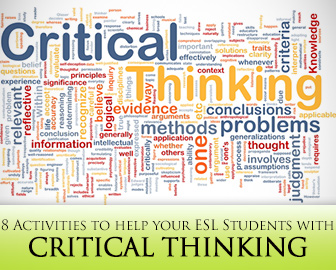
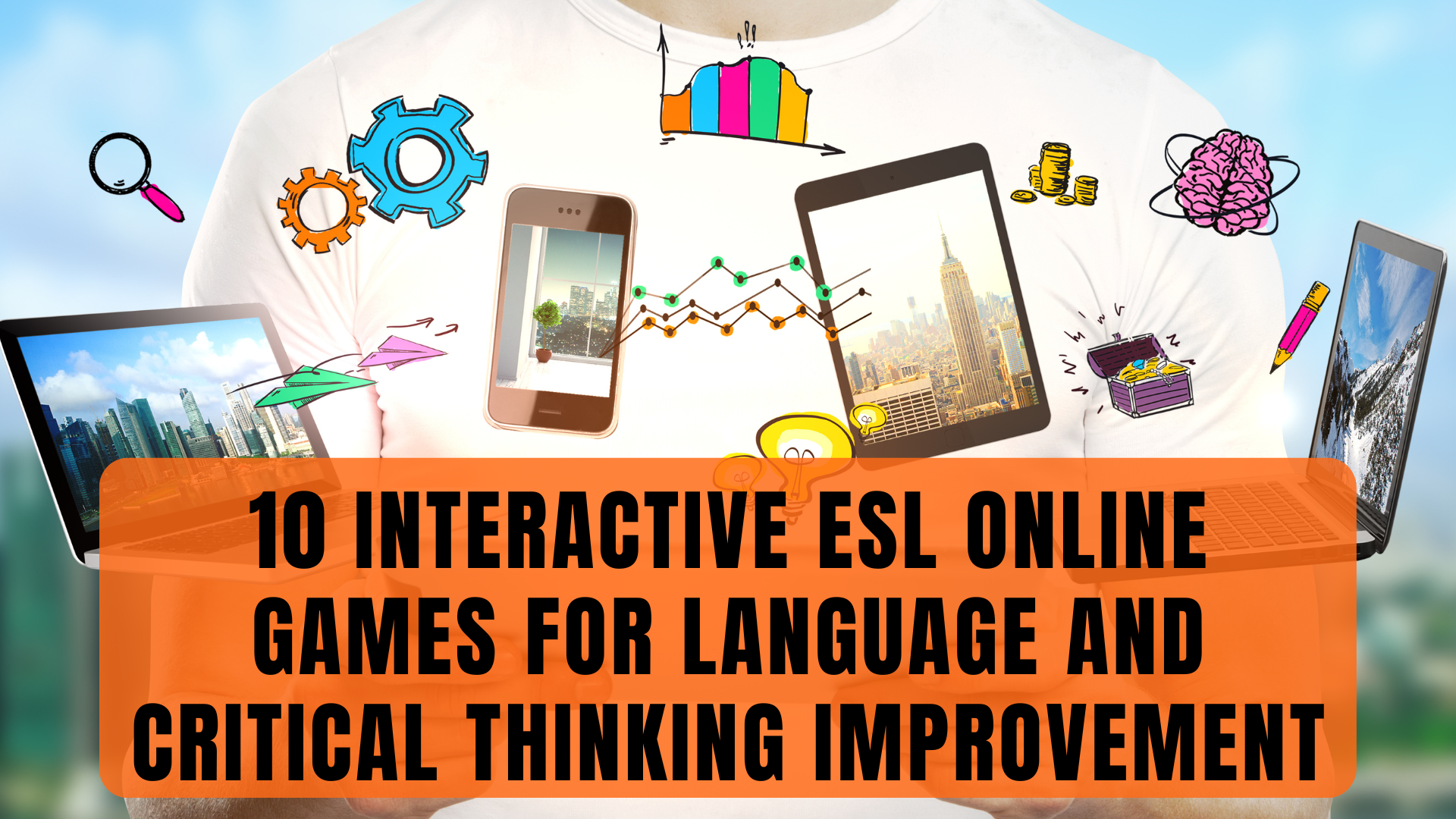
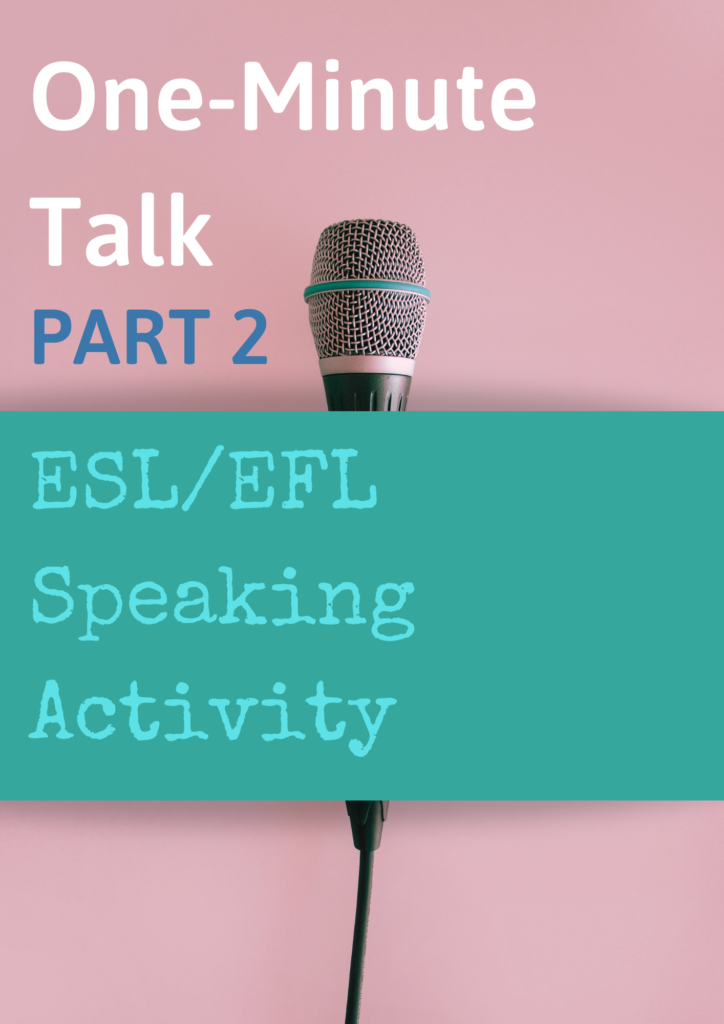












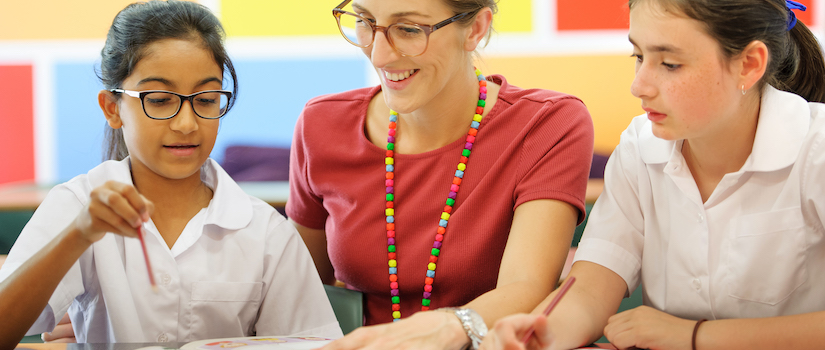







IMAGES
VIDEO
COMMENTS
Critical thinking is a key skill needed for everyday life. It should be applied to all aspects of a learner's studies, no matter their age or ability. It's a way of adding perspective, questioning intent and understanding ways of improving. Take a minute to watch this short video. It will help you to understand what we mean by Critical ...
Draw conclusions, make decisions, prioritize them; Take action and create steps to make your decisions applicable to the initial question. It might not always be possible to follow all steps in the language classroom, depending on the activity. That should not mean we should not teach critical thinking, even (and especially) to young students.
Table of Contents. 19 Short Stories and Questions - Suggestions for Teaching Them. 1. "The Most Dangerous Game". 2. "An Occurrence at Owl Creek Bridge". 3. "The Masque of the Red Death". 4.
Critical thinking is the process of using higher-order thinking skills in which students observe, conceptualize, apply, evaluate, and synthesize information that they learn in order to solve problems and make decisions effectively. Critical thinking is crucial for middle school students to be equipped to respond to academic, social, and emotional challenges successfully. As an educator, …
Check out these critical thinking activities, adapted from Critical Thinking in the Classroom , a book with over 100 practical tools and strategies for teaching critical thinking in K-12 classrooms. Four Corners. In this activity, students move to a corner of the classroom based on their responses to a question with four answer choices.
In this week's Teacher's Corner, a read-aloud task is used as the framework for a more demanding task that targets critical thinking skills as well. The task asks learners to process and then summarize the content of a story while reading aloud in a group. Level. Intermediate and above. Language Focus.
Critical thinking activities engage students' logic, rationality and judgment in problem-solving inquiries. English classes benefit from critical thinking activities because the activities activate students' prior knowledge, encourage creative thinking and stress the importance of evidence-based problem ...
Then try these critical thinking activities and games. Finally, try to incorporate some of these 100+ Critical Thinking Questions for Students into your lessons. They'll help your students develop the skills they need to navigate a world full of conflicting facts and provocative opinions. ... She holds a B.S. degree in Secondary English ...
TED-Ed lessons on the subject Critical Thinking. TED-Ed celebrates the ideas of teachers and students around the world. ... English Esperanto Estonian Faroese Filipino ... Thinking & Learning How to quit your job — without ruining your career - Gala Jackson. Lesson duration 06:13 111,638 Views. 05:21 ...
Other Critical Thinking Activities. Jigsaw—Developing Community and Disseminating Knowledge: Learners take on the role of "experts" or "specialists" of a particular topic. Then a panel of experts is assembled to get the larger picture. K-W-L Charts—Assessing What We Know/What We Still Want to Learn: Charts to document "What I Know ...
ESL Critical Thinking and Problem-Solving Activity - Speaking: Ranking, Guided Discussion, Guessing, Communicative Practice - Group Work - Upper-intermediate (B2) - 30 minutes. In this communicative critical thinking and problem-solving activity, students guess what criteria was used to put a list of ten jobs in order.
1. Ask the class who, in their own opinion, wins and why? 2. Ask students to pretend to be the item that they choose, try to list its advantages, and debate them with the other student. 3. Ask students to act out what they prepared in front of the class. 4. Ask the class to listen and take notes.
6. Start a Debate. In this activity, the teacher can act as a facilitator and spark an interesting conversation in the class on any given topic. Give a small introductory speech on an open-ended topic. The topic can be related to current affairs, technological development or a new discovery in the field of science.
Series 3, episode 7: What is critical thinking and how can we integrate it into English language teaching? This week, Chris and We'am discuss critical thinking - what does it mean, why is it important and what role does it have to play in English language teaching? Chris and We'am start by talking about critical thinking as a mindset rather than as a skill separate to other learning. First ...
10 Minute Critical Thinking Activities for English. Get your classes off to a lively start and build language arts and thinking skills with these 180 openers. Activities are grouped in 10 categories: five-minute writing ideas, grammar, famous quotations, figures of speech, games, the senses, vocabulary, alphabet, spelling, and poems.
According to Benjamin Bloom's taxonomy ( Taxonomy of Educational Objectives, 1956), thinking skills are divided into lower-order and higher-order skills. Lower-order skills include knowledge, comprehension, and application; higher-order skills include analysis, synthesis, and evaluation. To stimulate critical thinking in ELT, teachers need to ...
You can encourage your students to express logical and reasonable supports for their opinions during discussions and for writing assignments. Doing so will help them think analytically which is part of thinking critically. Have students give reasons or examples that support their ideas, and they will learn to support their arguments naturally. 7.
2. Real-Life Practice. Many games simulate real-life situations. This allows students to practice their language skills in relevant and practical ways. 3. Improved Critical Thinking Skills. Games that teach critical skills, such as spotting fake news and hoaxes, and media literacy, help students improve their critical thinking and media ...
Critical thinking is a key skill that goes far beyond the four walls of a classroom. It equips students to better understand and interact with the world around them. Here are some reasons why fostering critical thinking is important: Making Informed Decisions: Critical thinking enables students to evaluate the pros and cons of a situation ...
In schools, critical thinking is mostly treated as a general skill that can be taught in a generic way. The academic load sure makes adding the teaching of critical thinking a challenge, let alone teaching the specific skills for each subject and area of knowledge. However, there is evidence that it's very difficult for students to transfer ...
To become critical thinkers, students need to learn how 'to recognise or develop an argument, use evidence in support of that argument, draw reasoned conclusions, and use information to solve problems.' 1. English lessons are an ideal environment to foster critical thinking as they provide numerous opportunities for students to engage with ...
Writing to learn activities can be used in three ways: As a way of helping students practice crucial habits of thought you'd like them to master. Think about the particular kinds of critical thinking you want your students to perform. Design a low stakes activity in class that allows them to work through that way of thinking.
Teach Reasoning Skills. Reasoning skills are another key component of critical thinking, involving the abilities to think logically, evaluate evidence, identify assumptions, and analyze arguments. Students who learn how to use reasoning skills will be better equipped to make informed decisions, form and defend opinions, and solve problems.
Sherman Hutcherson, who has taught the class for many years, describes it as "a class that forces students to think about their own thinking." IB students across the world take the two ...
Creativity and critical thinking prepare students for innovative economies and improve wellbeing. However, educators often lack guidance on how to equip students with creativity and critical thinking within subject teaching. Education systems have likewise rarely established ways to systematically assess students' acquisition of creativity and critical thinking.